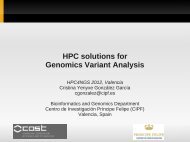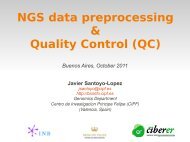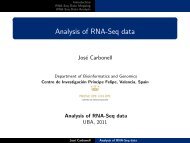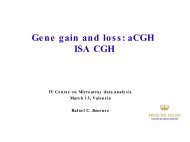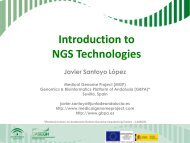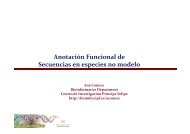Functional annotation with Blast2GO
Functional annotation with Blast2GO
Functional annotation with Blast2GO
You also want an ePaper? Increase the reach of your titles
YUMPU automatically turns print PDFs into web optimized ePapers that Google loves.
<strong>Functional</strong> <strong>annotation</strong> <strong>with</strong> <strong>Blast2GO</strong>
Index<br />
Why <strong>Blast2GO</strong> Concepts on functional<br />
<strong>annotation</strong><br />
o Function assignment<br />
o Vocabularies<br />
o GO and GOA<br />
o The GO Direct Acyclic Graph<br />
o The problem of function transfer<br />
<strong>Blast2GO</strong> Java application + Practicals<br />
<strong>Blast2GO</strong> @ Babelomics + Practicals<br />
2
Why <strong>Blast2GO</strong><br />
Experiment<br />
Data-Analysis<br />
Gene-List<br />
<strong>Functional</strong><br />
interpretation<br />
MNAT1<br />
CTNNBL1<br />
ENOX2<br />
GTPBP1<br />
RALY<br />
TAGLN2<br />
RAB3A<br />
PPP2R5A<br />
MAPRE1<br />
.....<br />
...<br />
<strong>Functional</strong><br />
Annotation<br />
+<br />
<strong>Functional</strong><br />
Profiling<br />
3
What does <strong>Blast2GO</strong> do<br />
Generates <strong>annotation</strong>s<br />
Visualization of funcional <strong>annotation</strong>s<br />
4
Concepts of functional <strong>annotation</strong><br />
Gene/Protein function<br />
• Referes to the molecular function of a gene or a<br />
protein:<br />
Tyrosine kinase<br />
<strong>Functional</strong> <strong>annotation</strong><br />
• More general, referes to the characterization of<br />
functional aspect of the protein.<br />
Stress-related, cytoplasm, ABC transporter<br />
• Also referes to the process of assingment of a<br />
function label<br />
• Habitually, standard vocabularies are used to<br />
assign function<br />
5
<strong>Functional</strong> Vocabularies<br />
Molecular Function<br />
Biological Process<br />
Cellular Component<br />
Metabolic pathways<br />
KEGG orthologues<br />
<strong>Functional</strong> motifs<br />
6
The GO has a DAG structure<br />
7
KEGG records pathways<br />
8
InterPro indicate functional motifs<br />
9
<strong>Functional</strong> assignment<br />
Annotation<br />
Literature<br />
reference<br />
Empirical<br />
Transference<br />
Filogeny<br />
Molecular<br />
interactions<br />
Biochemical<br />
assay<br />
Structure<br />
Comparison<br />
Sequence<br />
analysis<br />
Gene/protein<br />
expression<br />
Identification<br />
of folds<br />
Motif identification<br />
Sequence<br />
homology<br />
10
Automatic <strong>annotation</strong><br />
GO <strong>annotation</strong>s can be created by comparision<br />
to annotated sequences<br />
To achieve enough coverage, high-throughput,<br />
automatic <strong>annotation</strong> is required<br />
The most effective (also error prone) automatic<br />
<strong>annotation</strong> method is transfer from sequence<br />
similarity<br />
11
Concerns in functional transfer by similarity<br />
GO 1<br />
, GO 2<br />
, GO 3<br />
, GO 4<br />
QUERY<br />
GO 1<br />
, GO 2<br />
, GO 3<br />
, GO 4<br />
Level of homology (~ from 40-60% is possible)<br />
The overlap query and hit sequences<br />
The domain or structure function association<br />
The paralog problem: genes <strong>with</strong> similar sequences<br />
might have different functional specifications<br />
The evidence for the original <strong>annotation</strong><br />
Balance between quality and quantity: depends on the use<br />
HIT<br />
12
<strong>Blast2GO</strong><br />
Suite for functional <strong>annotation</strong> and data mining on<br />
functional data<br />
o Considerations for <strong>annotation</strong><br />
• Simlarity<br />
• Length of the overlap<br />
• Percentage of hit sequence spanned by the overlap<br />
• Evidence original <strong>annotation</strong><br />
• Blast hits and motif hits<br />
• Refinement by additional methods<br />
o Visualization:<br />
• Annotation charts<br />
• Knowledge discovery on the DAG<br />
Desktop Java application<br />
web interface @ Babelomics: Babelomics for non-model<br />
13
<strong>Blast2GO</strong> Annotation strategy<br />
Sq1<br />
Sq1<br />
Hit1<br />
Hit2<br />
Hit3<br />
Hit4<br />
Sq1<br />
Hit1<br />
Hit2<br />
Hit3<br />
Hit4<br />
go1,go2, go3<br />
go1,go3, go4<br />
go3,go5, go6,go8<br />
go1,go4<br />
Sq1<br />
go1,go2, go3<br />
go1,go3, go4<br />
go3,go5, go6,go8<br />
go1,go4<br />
Sq2<br />
Blast<br />
Sq2<br />
Hit1<br />
Hit2<br />
Hit3<br />
Hit4<br />
Mapping<br />
Sq2<br />
Hit1<br />
Hit2<br />
Hit3<br />
Hit4<br />
go6,go9, go8<br />
go1,go8<br />
go4,go1, go8,go9<br />
Annotation<br />
Sq2<br />
go6,go9, go8<br />
go1,go8<br />
go4,go1, go8,go9<br />
Sq3<br />
Sq3<br />
Hit1<br />
Hit2<br />
Hit3<br />
Hit4<br />
Sq3<br />
Hit1<br />
Hit2<br />
Hit3<br />
Hit4<br />
go2<br />
go2,go4, go4<br />
go2,go5, go6<br />
go2,go4<br />
Sq3<br />
go2<br />
go2,go4, go4<br />
go2,go5, go6<br />
go2,go4<br />
Sq4<br />
Sq4<br />
Hit1<br />
Hit2<br />
Sq4<br />
Hit1<br />
Hit2<br />
Sq4<br />
14
<strong>Blast2GO</strong> Annotation Strategy<br />
Sq1<br />
go1,go2, go3<br />
go1,go3, go4<br />
go3,go5, go6,go8<br />
go1,go4<br />
Sq1<br />
go1,go2, go3,<br />
GO11<br />
Sq2<br />
go6,go9, go8<br />
go1,go8<br />
go4,go1, go8,go9<br />
Refinement<br />
Sq2<br />
go8,<br />
GO12, GO13<br />
Sq3<br />
go2<br />
go2,go4, go4<br />
go2,go5, go6<br />
go2,go4<br />
InterPro<br />
Annex<br />
GOSlim<br />
Manual<br />
Sq3<br />
go2,go4<br />
Sq4<br />
Sq4<br />
GO15<br />
15
<strong>Blast2GO</strong> <strong>annotation</strong> rule<br />
Lowest term above<br />
threshold<br />
Similarity requirement<br />
sim=<br />
∑ positives hsp<br />
∑ alignmentlength hsp<br />
Quality of<br />
<strong>annotation</strong> source<br />
EC weight<br />
IC 1<br />
TAS 1<br />
IDA 1<br />
IMP 0.9<br />
IGI 0.9<br />
IPI 0.9<br />
ISS 0.8<br />
IEP 0.8<br />
NAS 0.7<br />
IEA 0.7<br />
ND 0.5<br />
NR 0.5<br />
RCA 0.5<br />
Evidence codes<br />
Possibility of abstraction<br />
Recall<br />
vs.<br />
Precision<br />
Lowest.node [(max.sim x ECw) + (#GO-1 x GOw) >= threshold]<br />
16
<strong>Blast2GO</strong> <strong>annotation</strong> rule<br />
Lowest.node [(max.sim x ECw) + (#GO-1 x GOw) >= threshold]<br />
- When I have a GO <strong>with</strong> ECw = 1 and I do not allow<br />
abstraction (GOw = 0), then the Annotation Score =<br />
%similarity<br />
- If the ECw < 1 my similarity requirement is higher to obtain<br />
the same Annotation Score<br />
- If I allow abstraction GOw > 0, then <strong>with</strong> less similarity I can<br />
obtain the required Annotation Score at a parent node<br />
17
Usage<br />
mamalians; 5<br />
fungi; 10<br />
insect/artropods<br />
; 18<br />
plant; 26<br />
microorganisms<br />
; 13<br />
tools; 24<br />
fish; 22<br />
18
Hands-on
www.blast2go.org<br />
LAUNCH B2G<br />
20
Input data (in fasta format)<br />
>my_favourite_species_seq1 | still unknown<br />
gtgatggaaaagaaaagttttgttatcgtcgacgcatatgggtttctttttcgcgcgtattatgcgctgcctggattaagcacctcatacaattttcctgtaggag<br />
gtgtatatggttttataaacatacttttgaaacatctctctttccacgatgcagattatttagttgtggtatttgattcggggtcgaaaaattttcgtcacactatgtatt<br />
ccgaatacaaaactaatcgccctaaagcaccagaggatctgtcactacaatgtgctccgctacgtgaggctgttgaagcgtttaatattgtaagtgaaga<br />
agtgcttaactacgaagcagacgacgtaatagctacactctgtacaaaatatgcatctagtaatgttggagtgagaatactgtcagcagataaggatttac<br />
tacaactcctaaatgataatgttcaagtttacgaccctataaaaagcagatacctcaccaatgaatacgttttagaaaaatttggtgtttcatcagataagttg<br />
as<br />
df<br />
catattgatacggttgcatcgagttataatgagaaaattattctcagctaagctgtacaccgtttattacacactcgaaaggccgttag<br />
>my_favourite_species_seq2 | no clue<br />
ttgttagctaaaaaggaagactttcacacctttggtaatggtgttggctctgctggaacaggtggagttgtagtttctgcatccatgttgtctgcggatttttcaaa<br />
tcttagagaagagatagcagcggttagtacggctggtgcagattggttacacattgatgtgatggatgggtgcttcgtccccagtttgactatgggtcctgtg<br />
asdf<br />
gtgatttccggcattaggaaatgtacaaatatgtttcttgatgtgcatttgatgattaatcgcccaggcgatcatctgaagagtgtggtagatgctggagctgat<br />
aagatagagcacattcgcaagatgatagaggaaagctcatcaaccgcgaaaatcgctgttgatggtggtgtttcaacggataatgcccgggctgttatcg<br />
aggcaggtgcgaatatactcgttgttggaacggcgctgtttgctgctgacgatatgagtaaagttgtaagaactttaaaatcattttaa<br />
>my_favourite_species_seq3 | just sequenced<br />
gtgggactgctcatccctgtaggcagggtggctattttttgtgtaaaggcagtctttcatagtcttgtaccgccatactatctatggataactacaaagcagttttt<br />
tgaggtgtggtttttctctcttcctatagtagcagttacatctttgtttacgggaggcgcgttagcccttcaggataccctcgtgggaagcgctaaagtatcagg<br />
gtaatggagtttttactcctgcaagatgtaatagagggtctggtaaaagctgtatcgtttgggctggtaatttcgctagttgggtgttacaacgggtatcactgtg<br />
agataggcgcaaggggtgtaggaacagcgacaacaaaaacttcggtagcagcttctatgctcataattttgttaaactatataattactgttttttacgcgta<br />
>my_favourite_species_seq4 | we will see soon...<br />
atgtacgctgtatctctttcaaatttgcatgtctctttcaacaacaaggaggttttgaaaggtgttgacttggacatagcatggggggattccctggttatactgg<br />
gagaatctggtagtggaaagtctgtactaacaaaggttgtattgggtctaatagtgccccaagagggaagtgttactgtagatggcaccaatattcttgaga<br />
ataggcagggcatcaagaattttagtgttttgtttcaaaactgtgcgttatttgacagtcttacgatttgggaaaatgtagtattcaatttccgtaggaggcttcgtt<br />
tagataaggataatgccaaggctttggctttacggggattggagcttgtgggattggacgccagtgtaatgaacgtgtatcctgtggagctatcaggcggg<br />
atgaaaaagcgcgtagctttggcaagagctattataggtagtcccaaaattctaattttggatgagccaacttcgggattggatcctataatgtcttcagtggt<br />
21
<strong>Blast2GO</strong> Application<br />
(1) Blast<br />
(2) Mapping<br />
(3) Annotation<br />
Table <strong>with</strong> all the<br />
sequence information<br />
Application statistics<br />
Blast results<br />
Application messages<br />
Graph visualisation<br />
22
Finding the homologues (BLAST)<br />
parameter descriptions<br />
Where to run Blast<br />
Choose Database<br />
Number of blast hits<br />
e-Value cut-off<br />
Blast algorithm<br />
Blast mode<br />
HSP length cut-off<br />
save your results apart<br />
23
pping to existing func. information<br />
24
Assigning function<br />
... setting the <strong>annotation</strong><br />
parameters ...<br />
25
Import and Export results<br />
SeqID GO ID SeqDesc.<br />
C01001C12 GO:0009507 at1g79420 t8k14_16<br />
C01001F11 GO:0003677 translin-associated factor x<br />
C01001G01 GO:0012505 ---NA---<br />
C01001H01 GO:0009987 pseudo-response regulator<br />
C01001H03 GO:0030001 proline-rich protein<br />
C01001H03 GO:0046872<br />
26
dd functions from protein domains<br />
Your e-mail address<br />
different methods offered<br />
by InterProScan from EBI<br />
27
Additional Annotations:<br />
InterPro Motifs and Kegg Maps<br />
• Ordered Kegg Map visualization<br />
• Highlighting of involved Sequences<br />
• Batch-InterPro-Motif searches<br />
• Add/merge GOs from domains to<br />
<strong>annotation</strong><br />
28
Modulation of <strong>annotation</strong>:<br />
GO Second Layer<br />
Extend <strong>annotation</strong> by the GO “Second Layer”<br />
Ref: Myhre, Tveit, Mollestad, Lægreid:<br />
Additional Gene Ontology structure for improved biological reasoning<br />
Bioinformatics, 2006<br />
29
Modulation of <strong>annotation</strong><br />
Chance <strong>annotation</strong> manually.<br />
GO-Term ACC<br />
EC-Codes<br />
Seq. Description<br />
Summarize <strong>annotation</strong> by “GoSlim”<br />
OBO GO-Slim File<br />
30
Visualisation<br />
• GO Graph Visualization as tool to explore and discover<br />
• Interactive and zoomable graphs<br />
• Colored graphs highlighting areas of interest<br />
set filters for more<br />
handy graphs<br />
31
Information Content<br />
color-highlighting<br />
Node Score<br />
Abundance analysis (Multilevel Pie)<br />
Khatri et al. Ontological analysis of gene<br />
expression data: current tools, limitations and<br />
open problems, Bioinformatics<br />
32
<strong>Blast2GO</strong> in Babelomics<br />
<br />
<br />
Annotation<br />
Visualization<br />
33
Annotation generation <strong>with</strong>in Babelomics<br />
34
Graph visualisation in Babelomics<br />
35
Several Examples/Exercises<br />
Blast, map and annotate several few sequences in <strong>Blast2GO</strong><br />
by loading the 10 test sequences (<strong>with</strong>in the file menu).<br />
Generate some singel-Seq GO graphs to review <strong>annotation</strong>.<br />
(right mouse click on sequence table)<br />
(http://www.blast2go.org → Start → 1024MB)<br />
Annotated 500 Citrus-Unigenes (nt) <strong>with</strong> <strong>Blast2GO</strong> as<br />
stand-alone and in Babelomics. Analyse the <strong>annotation</strong><br />
results. (For Babelomics: Leave default parameters; takes some 3 to 5<br />
minutes)<br />
Please find the corresponding instructions here:<br />
http://bioinfo.cipf.es/babelomicswiki/tool:<strong>annotation</strong><br />
Visualizes some gene <strong>annotation</strong>s (breast cancer) <strong>with</strong><br />
Babelomics GO-Graph-Viewer (using the ID-Converter Tools)<br />
(http://bioinfo.cipf.es/babelomicswiki/tool:gographviz)<br />
Import the gene <strong>annotation</strong>s (breast cancer) as .annot into<br />
<strong>Blast2GO</strong> and try to export a handy graph as PDF.<br />
36




